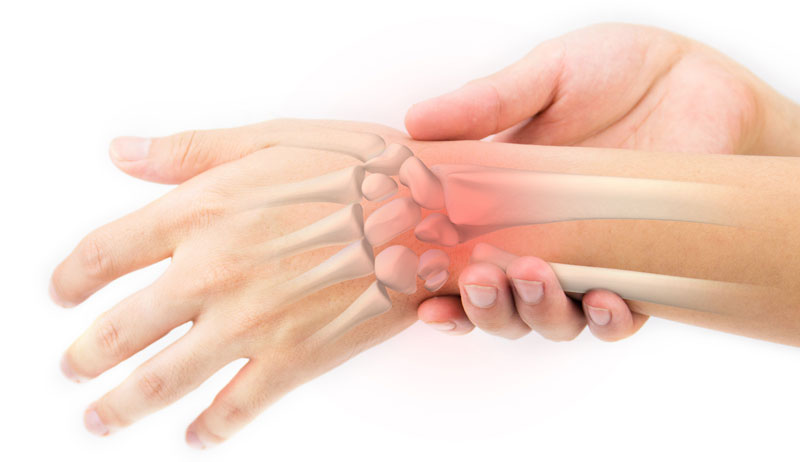Ever snapped your wrist back after a sudden sharp pain and thought, “What’s going on?” You’re not alone. Whether it’s from typing all day, a sports injury, or just a mystery ache, wrist pain can throw a wrench in your daily activities. But don’t stress, relief is within reach. In this blog, we will explore the possible causes of sharp wrist pain and provide tips for relieving it and preventing it from occurring again.
Contents
Causes Behind Sharp Pain In Wrist
 Wrist pain can sneak up on you, turning simple tasks into painful challenges. But what’s behind that shooting twinge or dull ache? The wrist is a complex hub of bones, ligaments, tendons, and nerves, making it susceptible to a range of issues. Let’s uncover some common causes:
Wrist pain can sneak up on you, turning simple tasks into painful challenges. But what’s behind that shooting twinge or dull ache? The wrist is a complex hub of bones, ligaments, tendons, and nerves, making it susceptible to a range of issues. Let’s uncover some common causes:
- Repetitive Strain Injuries: Ever spent hours on a keyboard or repeating the same wrist motions? This can lead to conditions like tendonitis, where tendons swell from overuse.
- Carpal Tunnel Syndrome: When the nerve that runs down your arm and into your hand gets squeezed at the wrist, it can cause pain, numbness, and tingling – classic signs of carpal tunnel syndrome.
- Arthritis: Both osteoarthritis and rheumatoid arthritis can hit the wrist, leading to pain, stiffness, and reduced movement. Osteoarthritis is about wear and tear, while rheumatoid arthritis is an autoimmune condition that attacks joints.
- Sprains and Fractures: A fall or sudden twist can stretch ligaments too far (sprain) or break bones (fracture) in the wrist, leading to sharp pain and swelling.
- Ganglion Cysts: These are fluid-filled lumps that can develop near wrist joints or tendons, sometimes causing pain or discomfort when moving the wrist.
Understanding the root cause of your wrist pain is crucial. It’s the first step toward effective treatment and getting your wrist – and your life – back to normal. If you’re dealing with persistent wrist pain, pinpointing the cause with a healthcare professional can guide you to the right treatment plan.
Identifying Symptoms: More Than Just Pain

Wrist pain isn’t just about the ache. Therefore, observing additional symptoms can give you and your doctor better clues about what’s really going on. Here’s what to watch out for:
- Numbness: This could be as simple as a lack of sensation in parts of your hand or fingers
- Tingling: That pins-and-needles feeling, often described as your hand “falling asleep”.
- Weakness: Struggling to grip objects or perform tasks you could easily do before? Yes, that’s a signal.
- Swelling: Visible puffiness around the wrist suggests inflammation, possibly from overuse, injury, or arthritis.
- Clicking or Popping Sounds: Hearing these noises when you move your wrist could indicate a ligament injury or a problem with the bones and joints in your wrist.
- Reduced Range of Motion: Difficulty bending your wrist or forming a fist, especially if it comes with pain, can be due to several issues, including severe strain or arthritis.
Noticing these symptoms and discussing them with a healthcare professional can help pinpoint the cause of your wrist discomfort. Whether it’s a nerve being pinched, a strained tendon, or something else, identifying all your symptoms is key to getting the right treatment and finding relief.
How Can I Stop This Sharp Wrist Pain?
 Dealing with sharp wrist pain can be frustrating, but there are several steps you can take to alleviate the discomfort and prevent it from worsening. Here’s what you can do to find relief and protect your wrist:
Dealing with sharp wrist pain can be frustrating, but there are several steps you can take to alleviate the discomfort and prevent it from worsening. Here’s what you can do to find relief and protect your wrist:
- Rest: Give your wrist a break from activities that trigger or aggravate the pain. Resting helps reduce further strain and inflammation.
- Ice Therapy: Apply an ice pack wrapped in a thin towel to your wrist for 15-20 minutes at a time, several times a day. Ice can help reduce swelling and numb the sharp pain.
- Compression: Use a wrist wrap or brace to support your wrist and keep swelling down. Make sure it’s snug but not too tight to cut off circulation.
- Elevation: Keep your wrist raised above your heart level, especially after an injury or during sleep, to help decrease swelling.
- Gentle Stretching: Perform slow, gentle stretches to maintain flexibility in your wrist and prevent stiffness. Avoid any movements that cause pain.
- Over-the-Counter Pain Relievers: Nonsteroidal anti-inflammatory drugs (NSAIDs), like ibuprofen or naproxen, can help manage pain and reduce inflammation. Always follow the recommended dosage and consult with a healthcare provider if you’re unsure.
- Modify Activities: Look for ways to adjust how you perform tasks that involve your wrist. Ergonomic tools or changes in technique can lessen strain on your wrist.
- Strengthening Exercises: Once the acute pain decreases, consider doing exercises to strengthen the muscles around your wrist. Stronger muscles provide better support and protection against future pain.
If these home remedies don’t bring relief or if your pain persists, it might be time to consult a healthcare professional. They can offer a diagnosis, suggest more specific treatments, and, if necessary, refer you to a specialist for further evaluation.
Now, When Should You Be Worried About Wrist Pain?
While occasional wrist pain from overuse or minor injury might not be a cause for alarm, there are certain signs that suggest it’s time to take your wrist pain seriously. Here’s when you should start worrying and consider seeking medical attention:
- If your wrist pain doesn’t improve with rest and home care after a few days
- Noticeable swelling that doesn’t go down or dramatic changes in skin color around the wrist
- A visible deformity in your wrist, like a lump or an unusual bend, especially after an injury
- Pain that wakes you up at night or significantly worsens when you’re trying to sleep
- Difficulty moving your wrist or hand, or an inability to carry objects or perform tasks that were easy before
- If your wrist pain is accompanied by fever, redness, or warmth, it could be a sign of infection or inflammatory arthritis.
If you experience any of these symptoms, it’s important not to dismiss them. Seeking advice from a healthcare professional can help determine the cause of your wrist pain and guide you toward the appropriate treatment to prevent further injury or complications.
Wrist Exercise That Will Help Relieve Pain

If sharp wrist pain is slowing you down, integrating specific exercises into your routine can help strengthen your wrist and alleviate discomfort. Here are some effective exercises designed to relieve wrist pain:
Wrist Flexor Stretch
- Extend your arm in front of you with your palm facing up.
- Use your other hand to gently pull the fingers back towards your body until you feel a stretch in your forearm.
- Hold for 15-20 seconds, then switch arms. Repeat 2-3 times per arm.
Wrist Extensor Stretch
- Extend your arm in front of you with your palm facing down.
- Gently pull the fingers towards your body with your other hand until you feel a stretch on the top side of your forearm.
- Hold for 15-20 seconds, then switch arms. Do 2-3 repetitions per arm.
Tennis Ball Squeeze
- Hold a tennis ball (or a stress ball) in your palm and squeeze it as hard as you can without causing pain.
- Hold the squeeze for 5 seconds, then release. Repeat 10 times on each hand.
Wrist Rotations
- Extend your arm in front of you, elbow straight, and make a fist.
- Rotate your wrist slowly in a circular motion, first clockwise, then counter-clockwise.
- Perform 10 rotations in each direction on each wrist.
Prayer Stretch
- Put your palms together in front of your chest, fingers pointing upwards, in a prayer position.
- Keeping your palms pressed together, slowly lower your hands towards your waist, keeping your hands close to your stomach.
- Hold when you feel a stretch under your forearms. Maintain the stretch for 15-20 seconds. Repeat 2-3 times.
Thumb Touches
- Hold your hand out with all fingers extended.
- One by one, touch the tip of each finger to the tip of your thumb, making an “O” shape.
- Perform this motion slowly and gently. Do 5 sets on each hand.
When to Seek Medical Attention for Wrist Pain
While many cases of wrist pain can be managed with home care and exercises, there are times when consulting a healthcare professional is crucial.
Advanced Treatment Options:

- Injections: For certain conditions, corticosteroid injections can reduce inflammation and provide pain relief.
- Physical Therapy: A customized physical therapy program can help strengthen your wrist and improve flexibility.
- Surgery: In cases where conservative treatments haven’t provided relief, or if there’s structural damage to the wrist, surgery might be recommended.
Consulting a healthcare professional early can help prevent your wrist pain from worsening and guide you toward the most effective treatments for your specific situation. Remember, getting the right diagnosis is the first step toward recovery.
Conclusion
Wrapping up, sharp wrist pain doesn’t have to be something you simply live with. Understanding its causes, recognizing when it’s more than just a temporary discomfort, and knowing the right exercises can all make a big difference. However, when pain persists or begins to interfere with your daily life, it’s a clear signal to seek professional help.
Physical therapy is a powerful tool in recovering from pain, offering tailored exercises and treatments that address your specific needs. Whether you’re battling back pain, shoulder discomfort, knee troubles, neck stiffness, elbow issues, hip pain, or the challenges of arthritis, the experts at MantraCare are here to support you on your journey to recovery. Book a physiotherapy session at MantraCare now and take the first step towards regaining your comfort and mobility. Let’s tackle that wrist pain together.


